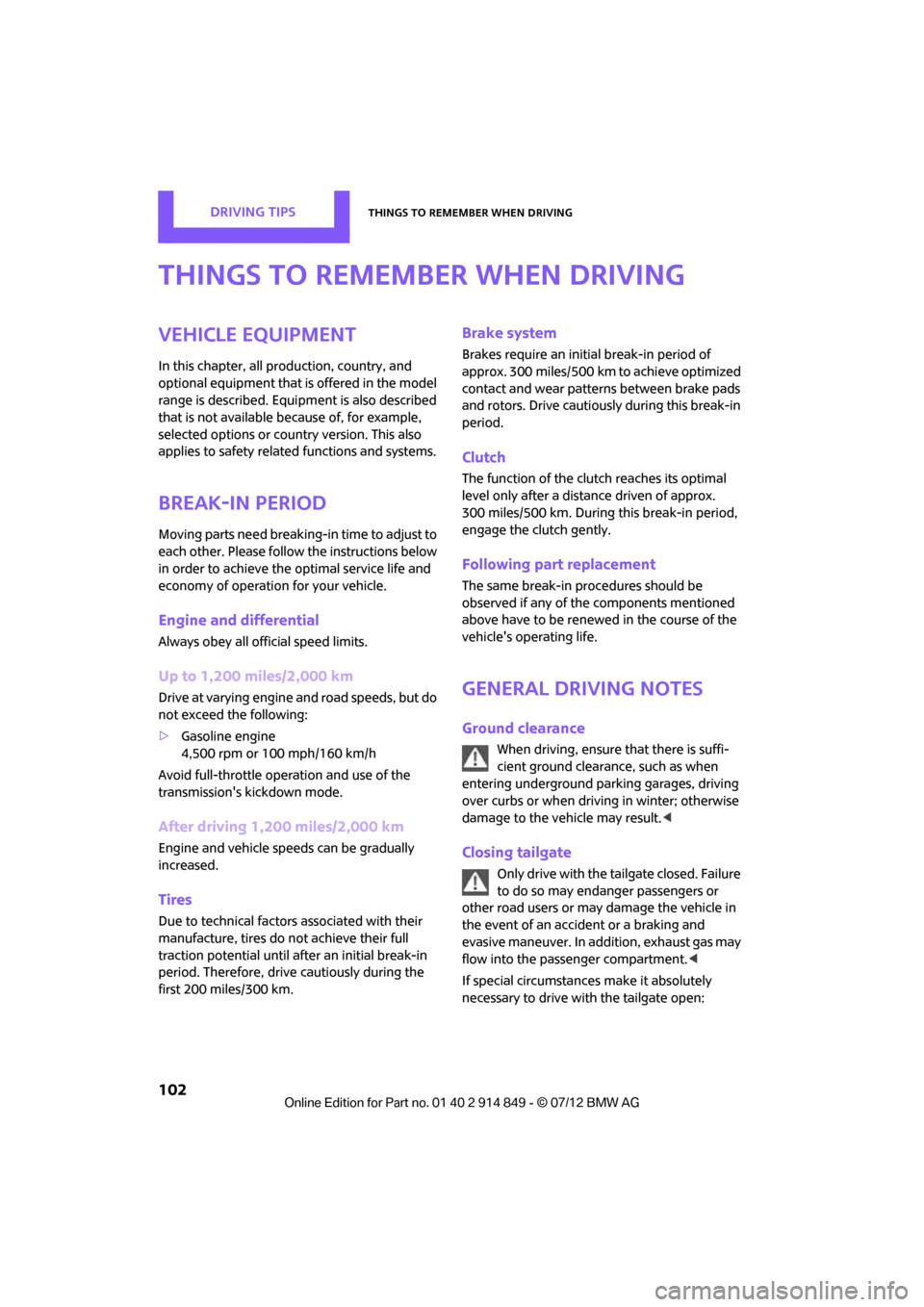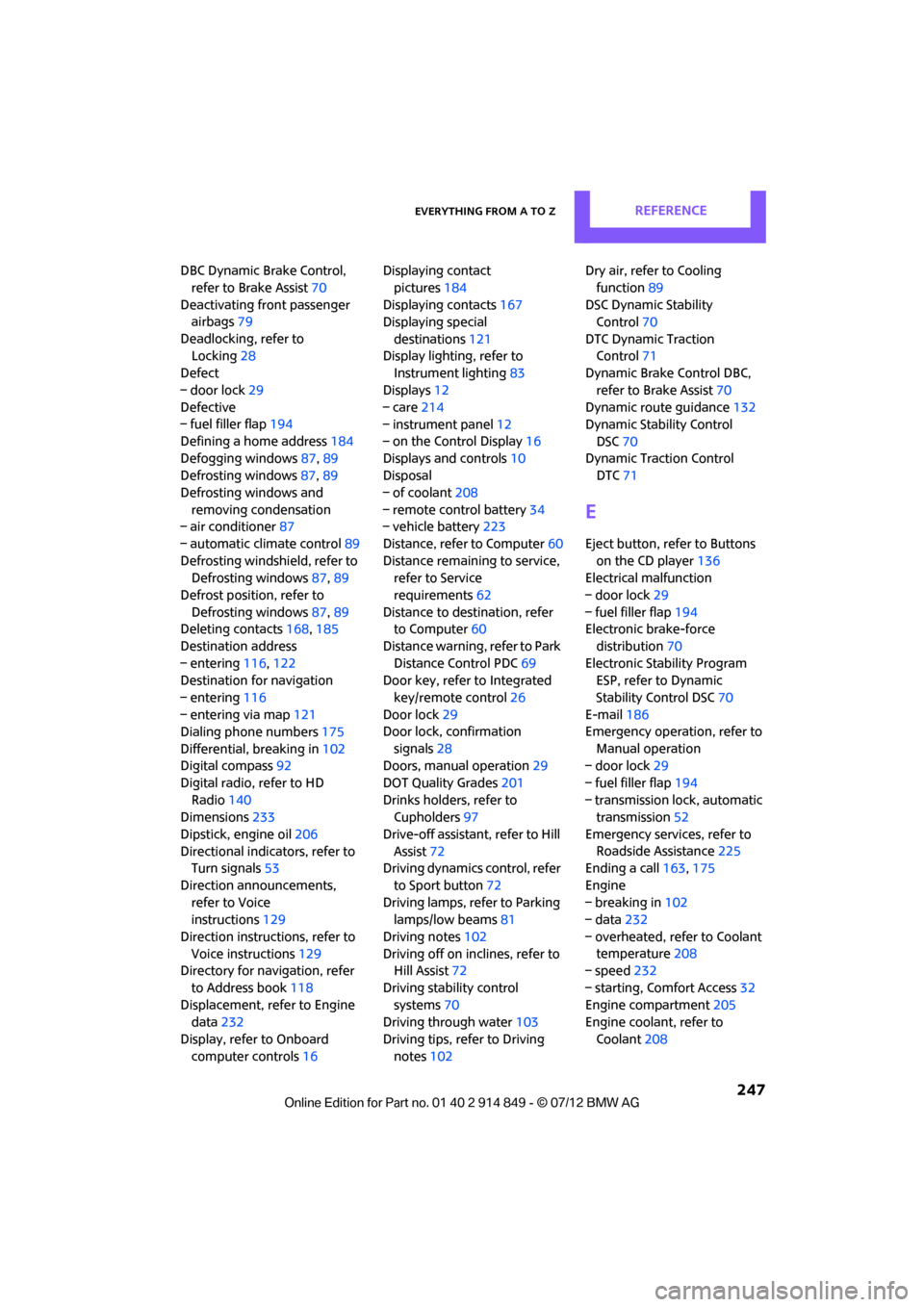differential MINI Countryman 2012 Owner's Manual (Mini Connected)
[x] Cancel search | Manufacturer: MINI, Model Year: 2012, Model line: Countryman, Model: MINI Countryman 2012Pages: 259, PDF Size: 3.07 MB
Page 73 of 259

CONTROLSTechnology for driving comfort and safety
72
Deactivating both DTC and DSC
Press the button for at least 3 seconds; the indi-
cator lamp DSC OFF on the speedometer comes
on and DSC OFF is displayed on the tachometer.
The Dynamic Traction Control DTC and Dynamic
Stability Control DSC are both deactivated. There
will be no more stabilizing interventions.
Interventions (differential lock) in braking occur
to improve propulsion when drive wheels are
rotating unevenly, even when DSC is deacti-
vated.
Activating DSC
Press the button again: the indicator lamps go
out.
Hill Assist
Hill Assist aids you in co mfortably driving off on
inclines. It is not necessary to use the parking
brake for this.
1. Hold the MINI with the brake.
2. Release the brake and immediately drive
off.
Hill Assist holds the car in place for approx.
2 seconds after the brake is released. Depending on the load and gradient, the
vehicle can roll backwa rd slightly during
this period. After you release the brake, immedi-
ately start driving since the Hill Assist only holds
the vehicle for about 2 seconds, and it will start
to roll backward. <
ALL4 all-wheel drive system
ALL4 is the all-wheel driv e system of your MINI.
The combined effects of ALL4 and DSC further
optimize the traction and dynamic driving
characteristics. The ALL4 all-wheel drive system
variably distributes the drive force to the front
and rear axle depending on the driving situation
and prevailing road conditions.
Sport button
Pressing the button causes your MINI to respond
even more sportily.
> Engine responds more spontaneously to
movements of the accelerator.
> Steering response is more direct.
> Cooper S, John Cooper Works: the engine
sounds more sporty in coasting mode.
With automatic transmission:
> More rapid gear shifting in Sport program.
Activating the system
Press the button.
The LED lights up.
SPORT is briefly displayed in the tachometer.
Deactivating the system
>Press the button again.
> Switch off the engine.
Online Edition for Part no. 01 40 2 914 849 - \251 07/12 BMW AG
Page 103 of 259

DRIVING TIPSThings to remember when driving
102
Things to remember when driving
Vehicle equipment
In this chapter, all production, country, and
optional equipment that is offered in the model
range is described. Equipment is also described
that is not available because of, for example,
selected options or coun try version. This also
applies to safety relate d functions and systems.
Break-in period
Moving parts need breaking-in time to adjust to
each other. Please follow the instructions below
in order to achieve the optimal service life and
economy of operation for your vehicle.
Engine and differential
Always obey all official speed limits.
Up to 1,200 miles/2,000 km
Drive at varying engine and road speeds, but do
not exceed the following:
> Gasoline engine
4,500 rpm or 100 mph/160 km/h
Avoid full-throttle operation and use of the
transmission's kickdown mode.
After driving 1,200 miles/2,000 km
Engine and vehicle speeds can be gradually
increased.
Tires
Due to technical factors associated with their
manufacture, tires do not achieve their full
traction potential until af ter an initial break-in
period. Therefore, drive cautiously during the
first 200 miles/300 km.
Brake system
Brakes require an initial break-in period of
approx. 300 miles/500 km to achieve optimized
contact and wear patterns between brake pads
and rotors. Drive cautiously during this break-in
period.
Clutch
The function of the clutch reaches its optimal
level only after a distan ce driven of approx.
300 miles/500 km. During this break-in period,
engage the clutch gently.
Following part replacement
The same break-in procedures should be
observed if any of the components mentioned
above have to be renewed in the course of the
vehicle's operating life.
General driving notes
Ground clearance
When driving, ensure that there is suffi-
cient ground clearance, such as when
entering underground parking garages, driving
over curbs or when driving in winter; otherwise
damage to the vehicle may result. <
Closing tailgate
Only drive with the tailgate closed. Failure
to do so may endanger passengers or
other road users or may damage the vehicle in
the event of an accident or a braking and
evasive maneuver. In a ddition, exhaust gas may
flow into the passenger compartment. <
If special circumstances make it absolutely
necessary to drive with the tailgate open:
Online Edition for Part no. 01 40 2 914 849 - \251 07/12 BMW AG
Page 248 of 259

Everything from A to ZREFERENCE
247
DBC Dynamic Brake Control, refer to Brake Assist 70
Deactivating front passenger airbags 79
Deadlocking, refer to Locking 28
Defect
β door lock 29
Defective
β fuel filler flap 194
Defining a home address 184
Defogging windows 87,89
Defrosting windows 87,89
Defrosting windows and removing condensation
β air conditioner 87
β automatic climate control 89
Defrosting windshield, refer to Defrosting windows 87,89
Defrost position, refer to Defrosting windows 87,89
Deleting contacts 168,185
Destination address
β entering 116,122
Destination for navigation
β entering 116
β entering via map 121
Dialing phone numbers 175
Differential, breaking in 102
Digital compass 92
Digital radio, refer to HD Radio 140
Dimensions 233
Dipstick, engine oil 206
Directional indicators, refer to Turn signals 53
Direction announcements, refer to Voice
instructions 129
Direction instructions, refer to Voice instructions 129
Directory for navigation, refer
to Address book 118
Displacement, refer to Engine data 232
Display, refer to Onboard computer controls 16Displaying contact
pictures 184
Displaying contacts 167
Displaying special
destinations 121
Display lighting, refer to Instrument lighting 83
Displays 12
β care 214
β instrument panel 12
β on
th
e Control Display 16
Displays and controls 10
Disposal
β of coolant 208
β remote control battery 34
β vehicle battery 223
Distance, refe r to Computer 60
Distance remaining to service, refer to Service
requirements 62
Distance to dest ination, refer
to Computer 60
Distance warning, refer to Park Distance Control PDC 69
Door key, refer to Integrated
key/remote control 26
Door lock 29
Door lock, confirmation
signals 28
Doors, manual operation 29
DOT Quality Grades 201
Drinks holders, refer to Cupholders 97
Drive-off assistant, refer to Hill
Assist 72
Driving dynamics control, refer
to Sport button 72
Driving lamps, refer to Parking lamps/low beams 81
Driving notes 102
Driving off on inclines, refer to Hill Assist 72
Driving stability control systems 70
Driving through water 103
Driving tips, refer to Driving notes 102 Dry air, refer to Cooling
function 89
DSC Dynamic Stability Control 70
DTC Dynamic Traction Control 71
Dynamic Brake Control DBC,
refer to Brake Assist 70
Dynamic route guidance 132
Dynamic Stability Control
DSC 70
Dynamic Traction Control DTC 71
E
Eject button, refer to Buttons
on the CD player 136
Electrical malfunction
β door lock 29
β fuel filler flap 194
Electronic brake-force
distribution 70
Electronic Stability Program ESP, refer to Dynamic
Stability Control DSC 70
E-mail 186
Emergency operation, refer to
Manual operation
β door lock 29
β fuel filler flap 194
β transmission lock, automatic transmission 52
Emergency services, refer to Roadside Assistance 225
Ending a call 163,175
Engine
β breaking in 102
β data 232
β overheated, refer to Coolant temperature 208
β speed 232
β starting, Comfort Access 32
Engine compartment 205
Engine coolant, refer to
Coolant 208
Online Edition for Part no. 01 40 2 914 849 - \251 07/12 BMW AG